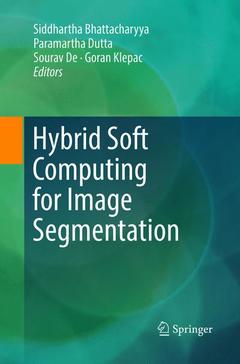Description
Hybrid Soft Computing for Image Segmentation, Softcover reprint of the original 1st ed. 2016
Coordinators: Bhattacharyya Siddhartha, Dutta Paramartha, De Sourav, Klepac Goran
Language: English
Subjects for Hybrid Soft Computing for Image Segmentation:
Publication date: 06-2018
Support: Print on demand
Publication date: 11-2016
321 p. · 15.5x23.5 cm · Hardback
Description
/li>Contents
/li>Comment
/li>
This book proposes soft computing techniques for segmenting real-life images in applications such as image processing, image mining, video surveillance, and intelligent transportation systems. The book suggests hybrids deriving from three main approaches: fuzzy systems, primarily used for handling real-life problems that involve uncertainty; artificial neural networks, usually applied for machine cognition, learning, and recognition; and evolutionary computation, mainly used for search, exploration, efficient exploitation of contextual information, and optimization.
The contributed chapters discuss both the strengths and the weaknesses of the approaches, and the book will be valuable for researchers and graduate students in the domains of image processing and computational intelligence.
Hybrid Soft Computing Techniques for Image Segmentation: Fundamentals and Applications.- Enhanced Rough-Fuzzy C-Means Algorithm for Image Segmentation.- Intuitionistic Fuzzy C-means Clustering Algorithm for Brain Image Segmentation.- Automatic Segmentation Approaches.- Modified Level Set Segmentation.- Fuzzy Deformable Models for 3D Segmentation of Brain Structures.- Rough Sets for Probabilistic Model Based Image Segmentation.- Segmentation of Cerebral Images.



